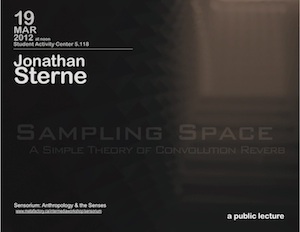Sampling Space:
A Simple Theory of Convolution Reverb
A public lecture by Jonathan Sterne (McGill University)
Time: March 19, 2012 at Noon
Location: Student Activity Center 5.118
Jonathan Sterne’s website: http://sterneworks.org/
excerpt from upcoming lecture:
 One of the most well-told anecdotes concerning John Cage’s life is the story of his visit to an anechoic chamber at Harvard University. In his own writings, Cage attributed to this experience his discovery that there is no such thing as silence, thus eventually leading to his infamous 4’33” composition. There is much that is possibly apocryphal about this story: it is not known which of Harvard’s two anechoic chambers Cage visited, and indeed, whether he really got the idea for silence from his visit there. One might reasonably wonder why he expected to achieve full silence in an anechoic chamber at all. The soundproof room — the camera silencia as Henning Schmidgen calls it — existed as a hallmark of modern psychology for over two decades by the time Cage visited, and some of the more famous of these rooms were made anechoic over time. Many psychologists and audition researchers had commented on the eerie experience of being in a room where there is no audible echo before Cage arrived in Cambridge. So it is no wonder that Cage’s bewilderment is matched perfectly by the engineer’s calm and knowing detachment: “the high one was your nervous system in operation. The low one was your blood in circulation.” What was remarkable about Cage’s experience, then, was not the quest for silence, but rather the effects of the absence of echo.
One of the most well-told anecdotes concerning John Cage’s life is the story of his visit to an anechoic chamber at Harvard University. In his own writings, Cage attributed to this experience his discovery that there is no such thing as silence, thus eventually leading to his infamous 4’33” composition. There is much that is possibly apocryphal about this story: it is not known which of Harvard’s two anechoic chambers Cage visited, and indeed, whether he really got the idea for silence from his visit there. One might reasonably wonder why he expected to achieve full silence in an anechoic chamber at all. The soundproof room — the camera silencia as Henning Schmidgen calls it — existed as a hallmark of modern psychology for over two decades by the time Cage visited, and some of the more famous of these rooms were made anechoic over time. Many psychologists and audition researchers had commented on the eerie experience of being in a room where there is no audible echo before Cage arrived in Cambridge. So it is no wonder that Cage’s bewilderment is matched perfectly by the engineer’s calm and knowing detachment: “the high one was your nervous system in operation. The low one was your blood in circulation.” What was remarkable about Cage’s experience, then, was not the quest for silence, but rather the effects of the absence of echo.
Selected Works:
The Audible Past: Cultural Origins of Sound Reproduction (Durham: Duke University Press, 2003)
MP3: The Meaning of a Format (Durham: Duke University Press, 2012)
“The Theology of Sound: A Critique of Orality,” Canadian Journal of Communication 36:2 (Summer 2011):207-225. (Original link here.)
“James Carey and the Resistance to Cultural Studies in North America Cultural Studies 23:2 (March 2009): 283-286.“Enemy Voice,” Social Text #96 25:3 (September 2008): 79-100.“Being ‘in the True’ of Sound Studies” Music, Sound and the Moving Image 2:2 (Autumn 2008): 163-167.
“Urban Media and the Politics of Sound Space,” in “Sound in Art and Culture,” a special issue of Open: Cahier on Art and the Public Domain #9 (Fall 2005): 6-15.
“The Burden of Culture.” In The Aesthetics of Cultural Studies, ed. Michael Bérubé, 80-102. Malden: Basil Blackwell, 2004.
as editor:
The Sound Studies Reader (London and New York: Routledge, 2012)
The Bad Subjects Anthology (New York: New York University Press, 1997)
